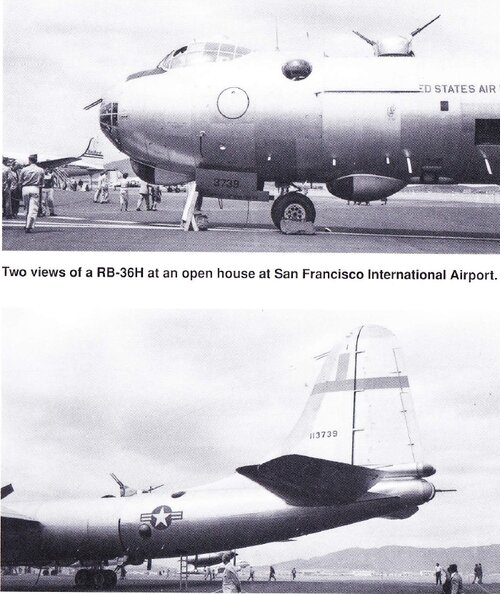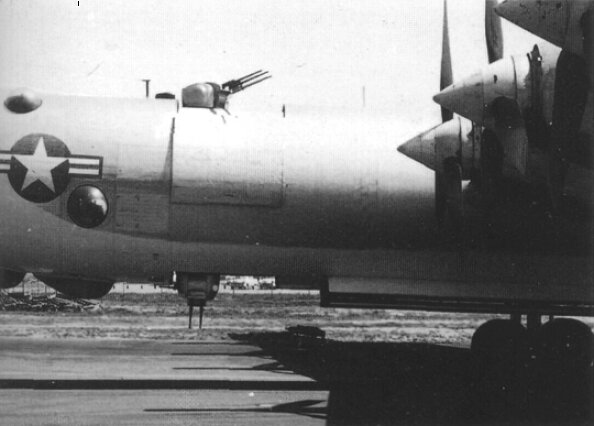Re: Why no B-36 in Korea
Might want to take a look at the SACs on your own site. At 45,000 feet and combat weight the F2H-2 looks to have a rate of climb of 1,000-1,600 feet per minute (depending on whether it has tip tanks) with a service ceiling around 51,000 feet. Rather doubt they had to strip it. And obviously they didn't have to strip it for when they took photos above fifty thousand feet.
Ah, but here's the crucial question: How long did they take to get up that high to take those photos, and how long did they stay up taking those photos?
Remember that intercepting a bomber is heavily dependent on time as a function -- time to climb to altitude, time before fuel exhaustion, time you can attack it, time before the bomber reaches it's target, etc.
Problem 1. Getting up There
The F2H-2 has two J34-WE-34 turbojets, for a total of 6,500 lbs of thrust.
SFC for the J34 is about 1.05 to 1.08 lb/lbf/hr, or 0.0175 to 0.018 lb/lbf/min. So at full power (necessary for those high climb rates); the F2H-2 would be consuming 114 to 117 pounds of fuel.
With it's combat weight fuel load of 3,157 pounds of fuel, that works out to:
* 26-28 minutes of powered flight if you disobey all rules and keep flying until fuel exhaustion and glide back home.
*17-18 minutes of powered flight if you obey the rules stating you must have 1,200~ lbs of fuel in reserve upon landing (look at landing weights in the SAC).
So looking at the rate of climb chart in the SAC, it breaks down minutewise as:
Launch (L)
L+1 Minutes = 7,200 ft (7,200 FPM climb previous minute)
L+2 Minutes = 13,600 ft (6,400 FPM climb previous minute)
L+3 Minutes = 19,200 ft (5,600 FPM climb previous minute)
L+5 Minutes = 24,000 ft (4,800 FPM climb previous minute)
L+6 Minutes = 28,400 ft (4,400 FPM climb previous minute)
L+7 Minutes = 32,400 ft (4,000 FPM climb previous minute)
L+8 Minutes = 36,000 ft (3,600 FPM climb previous minute)
L+9 Minutes = 39,100 ft (3,100~ FPM climb previous minute)
L+10 Minutes = 41,500 ft (2,400~ FPM climb previous minute)
L+11 Minutes = 43,800 ft (2,300~ FPM climb previous minute)
L+12 Minutes = 45,400 ft (1,600~ FPM climb previous minute)
L+13 Minutes = 46,700 ft (1,300~ FPM climb previous minute)
L+14 Minutes = 47,900 ft (1,200 FPM climb previous minute) <---You are now really pushing your luck if you want a couple minutes to attack the bomber, and still maintain your proscribed fuel reserve upon landing.
L+15 Minutes = 48,700 ft (800 FPM climb previous minute)
L+17 Minutes = 49,400 ft (700~ FPM climb previous minute)
L+18 Minutes = 49,800 ft (about 400 FPM climb previous minute)
L+19 Minutes = 50,150 ft (about 350 FPM climb previous minute)
L+20 Minutes = 50,450 ft (about 300 FPM climb previous minute)
L+21 Minutes = 50,700 ft (about 250 FPM climb previous minute)
L+22 Minutes = 50,900 ft (about 200 FPM climb previous minute)
L+23 Minutes = 51,100 ft (about 200 FPM climb previous minute)
L+24 Minutes = 51,300 ft (about 200 FPM climb previous minute)
L+25 Minutes = 51,500 ft (about 200 FPM climb previous minute) <-- I think it's safe to say that we've got zero movement up past this point. And you're about to run out of gas anyway give or take a couple minutes.
Now, obviously, one way to increase your time up high is to add more fuel, so you can keep running your engine longer. But there comes the problem.
You cant push takeoff weight past 15,640 pounds. So some weight has to be lost somewhere.
One obvious way is reducing gun armament.
The F2H-2 has four 20mm M-3 Cannons and 600 rounds. Each gun weighs 100 lbs, and it's 150 rounds per gun weighs about 75 pounds. So that's about 700 pounds for the four gun setup. If you reduced it to just two guns, you'd gain 350 pounds and three extra minutes in the air. The problem reducing firepower is that in World War II; the Germans estimated it took 20 hits to down a B-17; and it weighed only 36,000 lbs empty; compared to the B-36's 170,000 lbs empty.
Another way is reducing the protection the aircraft has.
Eliminating the 779 lbs of armor plate the pilot has for protection (731 front, 48 back) would gain you 6-7 minutes more of flight time -- and the 600 lbs of self sealing fuel tanks, would gain 5-6 more minutes, but you'd be very vunerable to gunfire.
Problem 2. Fighting Up There
The problem is, once you've gotten up that high, and have sufficient fuel to fight the bomber; the bomber can outturn you. The MiG-15 fully loaded had less wing loading than our combat loaded F2H-2; yet at 50,000~ feet, the MiG-15 required six minutes and 30,000~ ft radius turn to do a 360. The B-36 on the other hand, only required 17,500 ft radius and three minutes to do the same 360.
Well, yes, you could try turning tighter, but then you'll stall out; and basically be out of the fight.
This is why air to air missiles replaced cannon as fast as possible despite their obvious flaws that early in their development, because you didn't have to have a perfect firing angle to hit the bomber.
Additionally, there's also the problem of running down the bomber, if you end up in a tail chase due to various reasons.
The F2H at 50,000 ft had a top speed of about 440 kts TAS. Comparing this against the various B-36 models:
B-36B: 314 kt top speed; closing speed of 110 kts, or 2.4 miles a minute
B-36D: 340 kt top speed; closing speed of 100 kts, or 1.9 miles a minute
B-36J(III): 360+ kt top speed; closing speed of 80 kts, or 1.5 miles a minute
You can see how even a relatively smallish tail chase of only five miles will take at best
two minutes to complete, which is a problem if you've spent your fuel getting up that high.
Sorry for getting a bit technical here.




